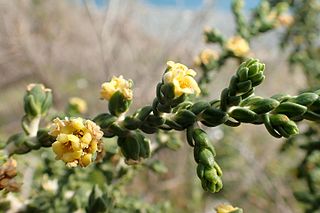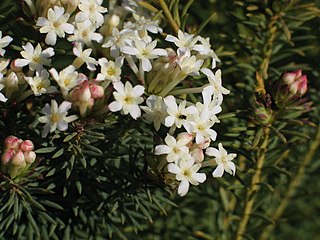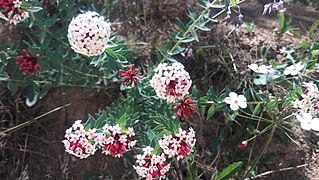
The Malvales are an order of flowering plants. As circumscribed by APG II-system, the order includes about 6000 species within 9 families. The order is placed in the eurosids II, which are part of the eudicots.
Gonystylus is a southeast Asian genus of about 30 species of hardwood trees also known as ramin, melawis (Malay) and ramin telur (Sarawak).

The Thymelaeaceae are a cosmopolitan family of flowering plants composed of 50 genera and 898 species. It was established in 1789 by Antoine Laurent de Jussieu. The Thymelaeaceae are mostly trees and shrubs, with a few vines and herbaceous plants.

Pimelea, commonly known as rice flowers, is a genus of plants belonging to the family Thymelaeaceae. There are about 150 species, including 110 in Australia and thirty six in New Zealand.
Botanical nomenclature is the formal, scientific naming of plants. It is related to, but distinct from taxonomy. Plant taxonomy is concerned with grouping and classifying plants; botanical nomenclature then provides names for the results of this process. The starting point for modern botanical nomenclature is Linnaeus' Species Plantarum of 1753. Botanical nomenclature is governed by the International Code of Nomenclature for algae, fungi, and plants (ICN), which replaces the International Code of Botanical Nomenclature (ICBN). Fossil plants are also covered by the code of nomenclature.

The Botanical Society of Britain and Ireland (BSBI) is a scientific society for the study of flora, plant distribution and taxonomy relating to Great Britain, Ireland, the Channel Islands and the Isle of Man. The society was founded as the Botanical Society of London in 1836, and became the Botanical Society of the British Isles, eventually changing to its current name in 2013. It includes both professional and amateur members and is the largest organisation devoted to botany in the British Isles. Its history is recounted in David Allen's book The Botanists.

Carl Daniel Friedrich Meissner was a Swiss botanist.
Gnidia socotrana is a species of plant in the Thymelaeaceae family. It is endemic to Yemen. Its natural habitats are subtropical or tropical dry forests and subtropical or tropical dry shrubland.

Gnidia is a genus of flowering plants in the family Thymelaeaceae. It is distributed in Africa, Madagascar, Arabia, India, and Sri Lanka; more than half of all the species are endemic to South Africa. Gnidia was named for Knidos, an Ancient Greek city located in modern-day Turkey.
Solmsia is a genus containing one or two species of flowering plants belonging to the family Thymelaeaceae. It is endemic to New Caledonia. The genus was named to honor Hermann zu Solms-Laubach by Henri Ernest Baillon. It is related to Arnhemia, Deltaria, Gonystylus and Lethedon.
Melaleuca gnidioides is a shrub in the myrtle family Myrtaceae and is endemic to the south of Grande Terre, the main island of New Caledonia. It is one of only a few members of its genus to occur outside Australia and is a small shrub with heads of white flowers which turn pink with age.
Pimelea gnidia is a species of small shrub in the family Thymelaeaceae. It is endemic to New Zealand. According to the New Zealand Threat Classification System (NZTCS), it is not threatened as of 2012.
Deltaria brachyblastophora is a species of shrubs in the Thymelaeaceae family. It is endemic to New Caledonia and the only species of the genus Deltaria. It is related to Arnhemia, Gonystylus, Lethedon and Solmsia.
Barbara Lynette Rye is an Australian botanist born in 1952.

Stellera is a genus of flowering plant in the family Thymelaeaceae, with a single species Stellera chamaejasme found in mountainous regions of Central Asia, China, Siberia and South Asia. S. chamaejasme is a herbaceous perennial plant with heads of white, pink or yellow flowers, grown as an ornamental plant in rock gardens and alpine houses, but considered a weed playing a rôle in the desertification of grasslands in parts of its native range. Like many others of its family, it is a poisonous plant with medicinal and other useful properties.
Diarthron is a genus of flowering plant in the family Thymelaeaceae. The precise limits of the genus are uncertain. When broadly circumscribed to include Dendrostellera and Stelleropsis, it consists of annual and perennial herbaceous plants and small shrubs, with reddish, white or green flowers lacking petals, and is found in central and south-west Asia and south-east Europe.

Octolepidoideae is a subfamily and one of the earliest branches of the Thymelaeaceae family. This species inherited multiple morphological character states from its ancestor, Thymelaeaceae. The calyx of a typical octolepidoideae is 5-merous. Researchers have found the species to contain 4-merous and 6-merous calyces, albeit they remain rarer.

Struthiola striata is a rounded, heather-like shrub of up to 1.5 m (4.9 ft) high that is assigned to the Thymelaeaceae family. It has small assending leaves on long straight branches, with cream, soft yellow or pinkish flowers in spikes, each of which consist of a tube of about 1 cm (0.39 in) long with 4 oval sepal lobes and 4 yellow alternating petal-like scales. It is sometimes called ribbed capespray or featherhead in English and roemenaggie, katstertjie or veërtjie in Afrikaans. It grows on coastal flats and foothills in the Western Cape province of South Africa.
Struthiola tetralepis is a willowy shrublet of up to 30 cm (0.98 ft) high that is assigned to the family Thymelaeaceae. It has long straight branches that are initially hairy and are covered in leaves pressed against them. These leaves are small, overlapping, lance-shaped, scharply pointed, have a regular row of hairs along the margins, and 3-5 veins are visible on the outward facing surface. It has initially greenish yellow, later reddish brown flowers, each of which consists of a tube of about 1 cm (0.39 in) long with 4 lance-shaped, pointed sepal lobes and 4 yellow alternating petal-like scales. It flowers between October and February. It can be found in the southwest of the Western Cape province of South Africa. It is sometimes called cross capespray in English.








